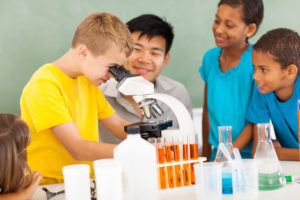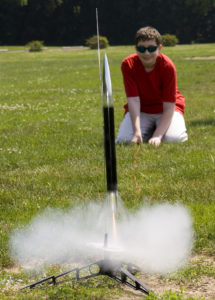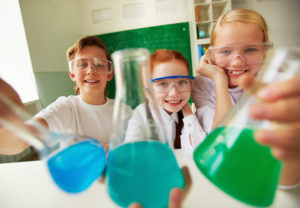
Teaching science isn’t always easy.
You see, there’s a lot more to it than most traditional science books and programs accomplish. If your students don’t remember the science they learned last year, you have a problem.
What do kids really need to know when it comes to science?
Kids who have a solid science and technology background are better equipped to go to college, and will have many more choices once they get out into the real world.
Learning science isn’t just a matter of memorizing facts and theories. On the contrary, it’s developing a deep curiosity about the world around us, AND having a set of tools that let kids explore that curiosity to answer their questions.
(Here’s the link for the teleclass mentioned in the video.)
Teaching science in this kind of way isn’t just a matter of putting together a textbook with a few science experiments and kits.
Science education is a three-step process (and I mean teaching science in a way that your kids will really understand and remember). Here are the steps:
- Get kids genuinely interested and excited about a topic.
- Give them hands-on activities and experiments to make the topic meaningful.
- Teach the supporting academics and theory.
Most science books and curriculum just focus on the third step and may throw in some experiments as an afterthought. This just isn’t how kids learn.
There is a better way. When you provide your kids with these three keys (in order), you can give your kids the kind of science education that not only excites them, but that they remember for many years to come.
Don’t let this happen to you… you buy science books or kits that were never used, and now your kids are filling out college applications and realizing they’re missing a piece of their education—a REALLY big piece. Now that’s a setback.
So what do you do?
First, don’t worry. This isn’t something that takes years and years to do. It just takes commitment.
What if you don’t have time? What I’m about to describe can take a bit of time as a parent, but it doesn’t have to. There is a way to shortcut the process and get the same results! But I’ll tell you more about that later.
Putting It Into Action
 Step one: Get students genuinely interested and excited about a topic.
Step one: Get students genuinely interested and excited about a topic.
Start by deciding what topic you want your students to learn. Then, you’re going to get them really interested in it.
For example, suppose I want my 5th grade to learn about aerodynamics. I’ll arrange for them to watch a video of what it’s like to go up in a small plane, of even find a friend who is a pilot and can come talk with the kids. This is the kind of experience that will really excite them.
Step two: Give your students hands-on activities and experiments to make the topic meaningful.
This is where I take that excitement and let them explore it. I have flying lesson videos, airplane books, and real pilots interact with my students. I’ll also show videos on how pilots plan for a flight. My students will learn about navigation, figuring out how much fuel is needed for the flight, how the weight the plane carries affects the aerodynamics of it, and so much more. (And did I just see a spot for a future math lesson also?)
I’ll use pilot training videos to help us figure this all out. Short of a live demo, video is incredibly powerful for learning. And my library is stocked with them.
My students are incredibly excited at this point about anything that has to do with airplanes and flying. They all want to be pilots someday and are already wanting flying lessons (remember, they are only 10 years old).
Step three: Teach the supporting academics and theory.
Now it’s time to introduce academics. Honestly, I have my pick of so many topics, because flying includes so many different fields. I mean, my students use angles and math in flight planning, mechanics and energy in how the engine works, electricity in all the equipment on board the plane, and of course, aerodynamics in keeping the plane in the air (to name just a few).
 I’m going to use this as the foundation to teach the academic side of all the topics that are appropriate.
I’m going to use this as the foundation to teach the academic side of all the topics that are appropriate.
We start with aerodynamics. They learn about lift and drag, make paper and balsa-wood gliders and experiment by changing different parts. They calculate how big the wings need to be to carry more weight (jelly beans) and then try their models with bigger wings.
Then we move on to the geometry used in navigation. Instead of drawing angles on a blank sheet of paper, our workspace is made of airplane maps (which I got for free from the airport).
We’re actually planning part of the next flight my students will “take” during their geography lesson. Suddenly angles are a lot more interesting. In fact, it turns out that we need a bit of trigonometry to figure out some things.
Of course, a 10-year old can’t do trigonometry, right? Wrong! They have no idea that it’s usually for high school and learns about cosines and tangents.
Throughout this, I’m giving them chances to talk with the pilot in class, share what they’ve learned with each other, and even plan a real flight. How cool is that to a kid?!
You get the idea. The key is to focus on building interest and excitement first, then the academics are easy to get students to learn.
Try starting with the academics and…well, we’ve all had the experience of trying to get kids do something they don’t really want to do.
The Shortcut
 Okay, so this might sound like it’s time-intensive. If you’re thinking “I just don’t have the time to do this!” or maybe “I just don’t understand science well enough myself to teach it to my students at that level.” If this is you, you’re not alone.
Okay, so this might sound like it’s time-intensive. If you’re thinking “I just don’t have the time to do this!” or maybe “I just don’t understand science well enough myself to teach it to my students at that level.” If this is you, you’re not alone.
The good news is, you don’t have to. The shortcut is to find someone who already specializes in the area you want your students to learn about and expose them to the excitement that persons gets from the field.
Then, instead of you being the one to take them through the hands-on part and the academics, use a solid video-based science program or curriculum (live videos, not cartoons).
This will provide them with both the hands-on experiments and the academic background they need. If you use a program that is self-guided (that is, it guides you and your students through it step-by-step), you don’t need to be hassled with the preparation.
I’m partial to the “e Science” program from www.SuperchargedScience.com (after all, I’m in it), but honestly, as long as a program uses these components and matches your educational goals, it should be fine.
Your next step should be to take a look at how you’re teaching science now and simply ask “Are my students getting the results I want for their science education?”
After this, consider how you can implement the three key steps we just talked about. Either go through the steps yourself, or use a program that does this for you.
If you want to learn more about how to teach science this way, we regularly give free online video classes for teachers and parents. My hope is that you have some new tools in your teaching toolbox to give your kids the best start you can in life.
Again, I want to thank you for taking the kind of interest in your students that it takes to be a great teacher. I know it’s like a wild roller coaster ride some days, but I also know it’s worth it. Have no doubt that that the caring and attention you give to your students’ education today will pay off many fold in the future. My best wishes to you and your students!
